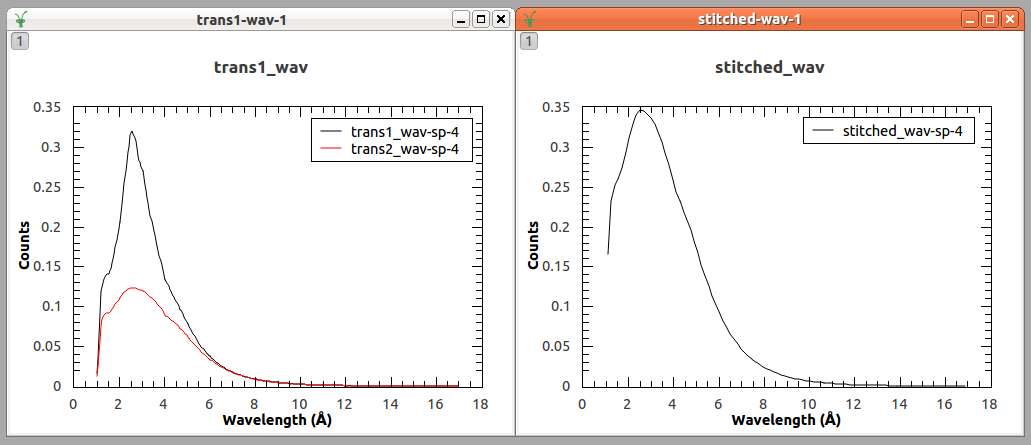Table of Contents
| Name | Direction | Type | Default | Description |
|---|---|---|---|---|
| InputWorkspaces | Input | str list | Input Workspaces. List of histogram workspaces to stitch together. | |
| OutputWorkspace | Output | Workspace | Mandatory | Output stitched workspace. |
| Params | Input | dbl list | Rebinning Parameters. See Rebin for format. | |
| StartOverlaps | Input | dbl list | Start overlaps for stitched workspaces. | |
| EndOverlaps | Input | dbl list | End overlaps for stitched workspaces. | |
| ScaleRHSWorkspace | Input | boolean | True | Scaling either with respect to workspace 1 or workspace 2 |
| UseManualScaleFactor | Input | boolean | False | True to use a provided value for the scale factor. |
| ManualScaleFactor | Input | number | 1 | Provided value for the scale factor. |
| OutScaleFactors | Output | dbl list | The actual used values for the scaling factores at each stitch step. |
Stitches single histogram Matrix Workspaces together outputting a stitched Matrix Workspace. This algorithm is a wrapper over Stitch1D v3.
The algorithm expects pairs of StartOverlaps and EndOverlaps values. The order in which these are provided determines the pairing. There should be N entries in each of these StartOverlaps and EndOverlaps lists, where N = 1 -(No of workspaces to stitch). StartOverlaps and EndOverlaps are in the same units as the X-axis for the workspace and are optional.
The workspaces must be histogrammed. Use ConvertToHistogram v1 on workspaces prior to passing them to this algorithm.
Example - a basic example using Stitch1DMany to stitch two workspaces together.
import numpy as np
def gaussian(x, mu, sigma):
"""Creates a gaussian peak centered on mu and with width sigma."""
return (1/ sigma * np.sqrt(2 * np.pi)) * np.exp( - (x-mu)**2 / (2*sigma**2))
#create two histograms with a single peak in each one
x1 = np.arange(-1, 1, 0.02)
x2 = np.arange(0.4, 1.6, 0.02)
ws1 = CreateWorkspace(UnitX="1/q", DataX=x1, DataY=gaussian(x1[:-1], 0, 0.1)+1)
ws2 = CreateWorkspace(UnitX="1/q", DataX=x2, DataY=gaussian(x2[:-1], 1, 0.05)+1)
#stitch the histograms together
workspaces = ws1.name() + "," + ws2.name()
stitched, scale = Stitch1DMany(InputWorkspaces=workspaces, StartOverlaps=[0.4], EndOverlaps=[0.6], Params=[0.02])
Output:

Example - a practical example using reflectometry data and a scale factor.
trans1 = Load('INTER00013463')
trans2 = Load('INTER00013464')
trans1_wav = CreateTransmissionWorkspaceAuto(trans1)
trans2_wav = CreateTransmissionWorkspaceAuto(trans2)
workspaces = trans1_wav.name() + ',' + trans2_wav.name()
stitched_wav, y = Stitch1DMany(workspaces, params='1, 0.05, 17', UseManualScaleFactor=True, ManualScaleFactor=0.85)
Output:

Categories: Algorithms | Reflectometry